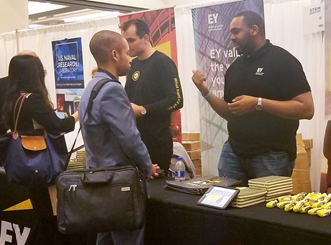Career Speed-Dating From Both Sides of the Table
Jessie Riley |
June 4, 2018
J/Career-Speed-Dating-From-Both-Sides-of-the-Table/STEMCareerFair_homepage-02.jpg.aspx?lang=en-US) ust one glance around the room at the STEM career fair in Washington, D.C. last April conjured a single sentiment: excitement.
ust one glance around the room at the STEM career fair in Washington, D.C. last April conjured a single sentiment: excitement.
Recruiters from big and small companies eagerly scanned the room, trying to catch the eye of a wandering student. Young men and women anxiously fiddled with their stack of resumes before gathering the courage to approach a brightly colored booth to shake hands with their potential employer.
In that moment, "student" became "professional" as they tried to envision themselves working alongside the engineers, biologists and astronauts depicted in the posters hanging beside each company’s table.
I couldn’t help but wonder: beyond the resumes and informational brochures, what entices someone to say ‘yes’ to a new job or a new employee? When both a recruiter and job-seeker meet in the professional equivalent to speed-dating, what pieces of information are crucial to convey?
After chatting with a few career fair participants, I began to see common themes emerge from both sides of the table.
From the job-seekers:
Community: More than anything, Julius was looking for a chance to join a community. At his last job in Houston, TX, he joined a group for black professionals within the company. He wants to work for an organization that pairs him with mentors that can guide him through his transition until he finds his niche.
Learning Opportunities: Shannon was a biology major at Frostburg State University. She’s passionate about animal conservation and the opportunity to explore new ideas in her classroom – especially her ornithology class. When I asked her what she wanted in her future job, she said “I’d jump at anything with a learning component. I love to learn.”
Flexibility: Each student I spoke to mentioned the desire for flexibility. Shannon wants to travel, while Julius is looking to work with multiple departments. Colleen, an Applied Math major at Salisbury University, wants to join a company that where employees are focused on helping each other rather than sticking to their specified roles.
F rom the recruiters:
rom the recruiters:
Problem-solving: Christopher from Lockheed Martin, a global aerospace, defense, security and advanced technologies company, said he’s mainly looking for energetic problem-solvers. “When someone comes with a problem to solve, I want someone who says ‘yes!’ every time.” A basic knowledge of both hardware and software doesn’t hurt, either.
Leadership: EY, a multinational professional services firm, is looking for well-rounded applicants, according to Natasha, EY’s director of talent. They want to see evidence of students taking opportunities outside of the classroom to advance their leadership skills. Lynn, the talent acquisition manager from Abbott, sought candidates with their hands in philanthropic work. “It’s not just about what you know – what do you do?”
Hard and Soft Skills: Nick at Rockwell Collins was mostly looking for lifelong learners: "School teaches you how to learn. Once you know that, we can teach you the rest." From EY to the Air Force Academy, recruiters underscored the importance of soft skills in addition to technical skills. While many of the companies looked for students with proficiency in coding and data analysis, every organization named collaboration and communication as two of the main qualities they look for in a candidate.
How can we best prepare students for a workforce that is constantly evolving? Foster the skills and dispositions that employers will always seek out: problem-solving, collaboration and leadership. We believe that high-quality STEM courses inherently promote critical-thinking and a desire for lifelong learning. Learn more about how NMSI is preparing students to tackle the world's toughest challenges.

 Want to see more blogs like this? Sign up for our monthly newsletter for subject-specific content.
Want to see more blogs like this? Sign up for our monthly newsletter for subject-specific content.
Don't miss it: check out our recap of the 2018 UTeach Conference.